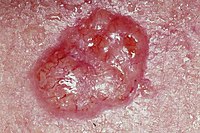
Photo from wikipedia
The incidence of malignant melanoma (MM) is continuously rising with nearly 300.000 cases worldwide in 2018, mostly due to improved early detection.1,2 Dermoscopy showed an excellent diagnostic accuracy to distinguish… Click to show full abstract
The incidence of malignant melanoma (MM) is continuously rising with nearly 300.000 cases worldwide in 2018, mostly due to improved early detection.1,2 Dermoscopy showed an excellent diagnostic accuracy to distinguish early melanoma from atypical, pigmented skin lesions, which is, among others, indicated by a low reported tumour thickness.3–6 However, ambiguous cases always require histopathological or molecular examination, which is still the gold standard. Several studies demonstrated that tape-stripping (TS), a technique to sample cells from the stratum corneum using adhesive tapes, can be used as a non-invasive alternative to tissue biopsies.7–11 TS has been initially described decades ago,12 but mostly in the context of assessing the morphology and number of keratinocytes using microscopy13–15 or to determine the percutaneous penetration of topically applied drugs.16 Early TS studies focused on epidermal pathology, but there is increasing research into the use of TS in other dermatoses, such as skin cancer,11,17 and themicrobiome.18 Moreover, TS has been used to quantify protein of the stratum corneumbyweight measurements or spectroscopy.19 More recently TS has been used to detect epidermal transcriptomic changes from melanoma.20 Using quantitative real-time polymerase, the company DermTech Inc. (La Jolla, CA, USA) offers a non-invasive assay to differentiate pigmented lesions from melanoma based on the expression of two marker genes for melanoma, LINC and PRAME.20 Cullison and colleagues tried to improve the diagnostic accuracy of this test, by including mutations analysis of genes commonly mutated in melanoma such as TERT, BRAF and NRAS.21 Moreover, TS enabled a differentiation of basal cell and squamous cell carcinomas from benign lesions.22 Although not recommended for routine diagnostic evaluation in cutaneous melanoma, molecular testing may be useful to identify BRAF V600 mutations, which are associated with sensitivity to BRAF inhibitors, MEK (also known as MAP2K, mitogen-activated portein kinase kinase) inhibitors, and a combination of the two.23 Furthermore, certain KITmutations, which are found in 10%–15% ofMMofmucosal and acral origin and in 2%–3% of MM that result from chronic sun exposure, appear to be highly sensitive to KIT inhibitors.23NRASmutations may provide prognostic information and are found in roughly 15%. Although extremely rare, fusions in NTRK1, NTRK2, NTRK3,
Journal Title: Skin Research and Technology
Year Published: 2023
Link to full text (if available)
Share on Social Media: Sign Up to like & get
recommendations!